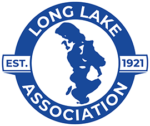LAKE MANAGEMENT TREATMENT COMMITTEE
CO-CHAIRS | BRENT SCHNELL & DAVE BAKER
We treat the invasive species Eurasian Watermilfoil (EWM) since it spreads quickly and proliferates, crowding out native plants and provides a lower quality habitat than the native plants for fish. It can also create dense mats near the water surface that entangle boat propellers and make it difficult to swim or fish. In 2023, approximately 9 acres were treated for Eurasian Watermilfoil (EWM). This represents only 0.3% of the combined total surface area/bottomlands of Long, Ruth, and Mickey lakes. The treatment area from 2022 to 2023 decreased by 25% which shows we continue to make progress lowering the EWM levels. This means we are in maintenance mode and have Eurasian Watermilfoil (EWM) under good control in our lakes at this point in time.
The Lake Management-Treatment Committee and our key lake management partners met on April 3, 2024. Clear Water Lake Management (our herbicide applicator) and Zero Gravity (aerial drone guidance) were at the meeting to help us review the 2023 results and do planning for 2024. The 2024 treatment plan will include a combination of ProcellaCOR, 2,4-D and benthic barriers. We plan to continue to treat the aquatic invasive species Eurasian Watermilfoil (EWM) twice this year, as usual, to improve the quality of the lakes for boating, etc., using advanced technology to precisely target the treatment to where it is needed. The 2024 plan is to treat approximately the same total area as in 2023 (e.g. 9 acres). Some areas were treated in 2023 that will not require treatment this year. The areas treated with ProcellaCOR were especially successful. Many of the sites that previously contained the aquatic invasive species Eurasian Watermilfoil (EWM) are growing native plants now that the Eurasian Watermilfoil is gone. Some areas were treated successfully in past years, but now the Eurasian Watermilfoil has returned, requiring treatment in 2024. Treatment dates for 2024 are Tuesday, June 25, 2024, and Tuesday, July 30, 2024. The rain date will be the next day, if necessary. The Long Lake Association (LLA) is also planning a second benthic barrier pilot in Long Lake in 2024.
Long Lake Association plans to increase use of ProcellaCOR EC by 33% in 2024 to control Eurasian Watermilfoil (EWM)
The Long Lake Association (LLA) continuously evaluates new potential treatments to best control Eurasian Watermilfoil (EWM) while minimizing any impacts on the lakes and people using the lakes. Based on this objective, the LLA will increase the usage of ProcellaCOR EC in Long and Mickey Lakes in June 2024 to control EWM due to the very positive results thus far.
ProcellaCOR EC is a new, state of the art treatment for invasive aquatic plant species like Eurasian Watermilfoil (EWM) with the benefits listed below:
- ProcellaCOR EC is selective. It targets explicitly Eurasian Watermilfoil (EWM) and other invasive aquatic plant species, and it won’t hurt the native plants we want in the lakes.
- ProcellaCOR EC reduces chemical usage through more extended control. Less product is required for treatment since ProcellaCOR EC has a unique formula that requires a 40x-100x less active ingredient that still achieves significantly longer control. A “Reduced Risk” classification from the EPA is designed to reduce risk to our health, non-target plants, and water supply. The EPA says ProcellaCOR EC is “practically non-toxic” to animals and humans.
- Since ProcellaCOR EC will keep EWM at bay for much longer than other solutions, it reduces the need for two treatments per year as is typically required with other treatment options.
- ProcellaCOR EC has a short half-life (when it takes half of the active ingredient to degrade) of only 6 hours and quickly dissipates with the water column. Typically, ProcellaCOR EC is not expected to be detectable in the water within 24 hours of treatment.
It should be noted that ProcellaCOR is cost-effective in shallow water applications but becomes prohibitively expensive in deeper water applications. Therefore, the LLA intends to focus its efforts on coming up with the best possible hybrid approach to EWM treatment, including other solutions like benthic barriers.
INVASIVE SPECIES FUNDING
The activities of the Lake Management Committee on all three lakes are funded by the Long Lake Association and our local partners. Thank you to Charter Township of Long Lake for supporting the drone guidance and EWM mapping efforts. Your LLA membership dues are an essential part of our funding to control the levels of Eurasian Watermilfoil (EWM) to protect our lake from this very aggressive aquatic invasive species. If you wish to provide further financial support for this program, the Long Lake Foundation (LLF) has created the “LLF Invasive Species Defense Fund” to fund further study and investigate remediation techniques of both aquatic and terrestrial invasive species in and around Long, Mickey, and Ruth Lakes. Your tax-deductible donation under the 501c3 designation of the IRS code to this critical fund will ensure our lakes’ effective management and health far into the future. Please visit the LLF website at www.longlakefoundation.org to learn about the Long Lake Foundation and donate online or mail a check to “Long Lake Foundation” to P. O. Box 31; Interlochen, MI 49643 and put “LLF Invasive Species Defense Fund” in the memo area.
NATURALLY OCCURRING BIO-FOAM

REFERENCE MATERIALS
Bio Foam | An Naturally Occurring Phenomenon | DEQ | Download File
Aquatic Plant Control | Things to Consider | Tony Groves & Pam Tyning | Download File
